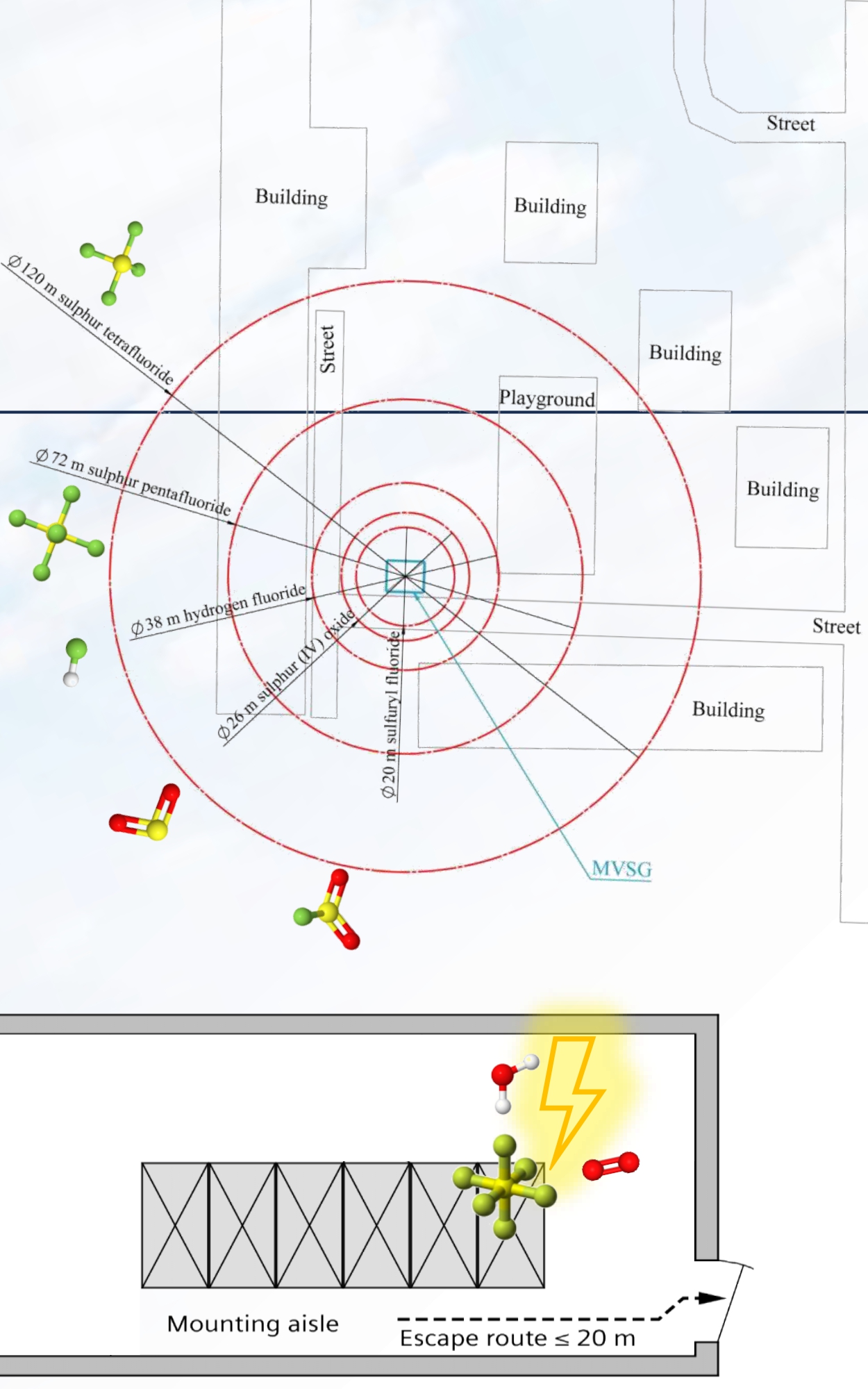Sulphur hexafluoride in modern medium-voltage switchgear: Advantages, hazards and environmental impact Scientific paper
Main Article Content
Abstract
Sulphur hexafluoride is synthesised as a persistent and non-toxic gas with an exceptional dielectric strength. In contemporary medium-voltage switchgear within power distribution systems, SF6 gas is used for the insulation and the extinction of electric arc. The application of SF6 has advantages in terms of gas physicochemical characteristics and performance; the dimensions, the cost-effectiveness, the reliability of the switchgear equipment and the duration, as well as the cost of maintenance were significantly reduced. SF6 is a known greenhouse gas, which tends to accumulate in the lungs, inducing oxygen depletion and respiratory complications. The by-products of SF6 formed during the electric arc can be harmful and toxic. The equipment containing SF6 is being replaced in the EU and worldwide. Using ALOHA® software the scenarios of leakage for SF6 and by-products were modelled in urban areas, where the switchgear is frequently placed. In areas where the circulation of wind is lower (urban areas), in hazardous situations, it is not possible to depend on high dispersion levels or minimisation of concentration and threat. The models have shown that SF6 poses an environmental problem and its by-products cause a serious health hazard in the case of leakage in urban areas, rendering red threat zones from 10 to 60 m in radius.
Downloads
Metrics
Article Details

This work is licensed under a Creative Commons Attribution 4.0 International License.

Authors retain copyright and grant the journal right of first publication with the work simultaneously licensed under a Creative Commons Attribution license 4.0 that allows others to share the work with an acknowledgement of the work's authorship and initial publication in this journal.
Funding data
-
Ministarstvo Prosvete, Nauke i Tehnološkog Razvoja
Grant numbers 451-03-68/2020-14/200156
References
W. T. Tsai, J. Fluor. Chem. 128 (2007) 1345 (https://doi.org/10.1016/j.jfluchem.2007.06.008)
C. T. Dervos, P. Vassiliou, J. Air Waste Manage. Assoc. 50 (2011) 137 (https://doi.org/10.1080/10473289.2000.10463996)
M. Maiss, C. A. M. Brenninkmeijer, Environ. Sci. Technol. 32 (1998) 3077 (https://doi.org/10.1021/es9802807)
IPCC Task Force on National Greenhouse Gas Inventories, https://www.ipcc-nggip.iges.or.jp/public/gp/english/ (accessed 29.10.2023)
S. Kumar, S. Sanjay, B. P. Yadav, N. A. Siddiqui, S. Varadharajanl, in Advances in Industrial Safety. Springer Transactions in Civil and Environmental Engineering. F. I. Khan, N. A. Siddiqui, S. M. Tauseef, B. P. Yadav, Eds., Springer, Singapore, 2020, p. 310 (https://doi.org/10.1007/978-981-15-6852-7_21)
Y. S. Son, S.J. Lee, C. Y. Choi, J. H. Park, T. H. Kim, I. H. Jung, Radiat. Phys. Chem. 124 (2016) 220 (https://doi.org/10.1016/j.radphyschem.2015.11.016)
A. Mete, P. Türkçüoğlu, S. Kimyon, K. Güngör, Int. Ophthalmol. 37 (2017) 1057 (https://doi.org/10.1007/s10792-016-0336-y)
M. N. Elmohamady, M. T. I. Khalil, A. S. M. Bayoumy, M. Rateb, H. M. Faramawi, Eye 35 (2021) 441 (https://doi.org/10.1038/s41433-020-0867-3)
R. Yang, M. Xu, J. Yan, M. Yang, Y. Geng, Z. Liu, J. Wang, Energies 14 (2021) 414 (https://doi.org/10.3390/en14020414)
EUR-Lex, Access to European Union law, https://eur-lex.europa.eu/legal-content/EN/TXT/PDF/?uri=CELEX:32014R0517 (accessed 11.11.2023)
UNCC Report of the Conference of the Parties on its twenty-seventh session, https://unfccc.int/documents/626564 (accessed 29.10.2023)
P. Forster, T. Storelvmo, in Climate Change 2021: The Physical Science Basis, V. Masson-Delmotte, P. Zhai, A. Pirani, S.L. Connors, C. Péan, S. Berger, N. Caud, Y. Chen, L. Goldfarb, M.I. Gomis, M. Huang, K. Leitzell, E. Lonnoy, J.B.R. Matthews, T.K. Maycock, T. Waterfield, O. Yelekçi, R. Yu, B. Zhou, Eds., Cambridge University Press, Cambridge, 2021, p. 2391 (https://doi.org/10.1017/9781009157896.009)
R. F. Weiss, J. Mühle, P. K. Salameh, C. M. Harth, Geophys. Res. Lett. 35 (2008) L20821 (https://doi.org/10.1029/2008GL035913)
Y.A. M. Alsumaidaee, C. T. Yaw, S. P. Koh, S. K. Tiong, C. P. Chen, K. Ali, Energies 15 (2022) 6762 https://doi.org/10.3390/en15186762
N. Dorraki, K. Niayesh, J. Phys. D: Appl. Phys. 54 (2021) 255503 (https://doi.org/10.1088/1361-6463/abf25a)
Y. Fu, A.Yang, X. Wang, A.B. Murphy, X. Li, D. Liu, Y. Wu, M. Rong, J. Phys., D 49 (2016) 385203 (https://doi.org/10.1088/0022-3727/49/38/385203)
M. Xu, J. Yan, M. Yang, Y. Geng, Z. Liu, J. Wang, AIP Adv. 10 (2020) 095214 (https://doi.org/10.1063/5.0018972)
USEPA Inventory of U.S. Greenhouse Gas Emissions and Sinks: 1990–2021, https://www.epa.gov/ghgemissions/inventory-us-greenhouse-gas-emissions-and-sinks-1990-2020 (accessed 11.11.2023.)
M. Meldrum, Regul. Toxicol. Pharmacol. 30 (1999) 110 (https://doi.org/10.1006/rtph.1999.1342)
W. T. Tsai, J. Environ. Sci. Health, C 28 (2010) 125 (https://doi.org/10.1080/10590501.2010.481806)
C. T. Dervos, P. Vassiliou, J. Air Waste Manage. Assoc. 50 (2000) 137 (https://doi.org/10.1080/10473289.2000.10463996)
C. Heaviside, C. Witham, S. Vardoulakis, Sci. Total Environ. 774 (2021) 145549 (https://doi.org/10.1016/j.scitotenv.2021.145549)
P. Füle, G. Kristóf, J. Wind. Eng. Ind. Aerodyn. 179 (2018) 407 (https://doi.org/10.1016/j.jweia.2018.06.015)
R. Yadav, S. Chaudhary, B. P. Yadav, S. Varadharajan, S. M. Tauseef, in Advances in Industrial Safety, Springer Transactions in Civil and Environmental Engineering, F.I. Khan, N.A. Siddiqui, S.M. Tauseef, B.P. Yadav, Eds., Springer, Singapore, 2020, p. 310 (https://doi.org/10.1007/978-981-15-6852-7_14)
J. Bondžić, M. Sremački, S. Popov, I. Mihajlović, B. Vujić, M. Petrović, J. Environ. Manage. 293 (2021) 112941 (https://doi.org/10.1016/j.jenvman.2021.112941)
World Weather, https://world-weather.info/archive/serbia/novi_sad/ (accessed 09.11.2023.)
Weather Atlas, https://www.weather-atlas.com/en/serbia/novi-sad-climate (accessed 09.11.2023.)
CAMEO® Chemicals, https://cameochemicals.noaa.gov/ (accessed 09.11.2023.)
NIST Chemistry WebBook, SRD 69, https://webbook.nist.gov/chemistry/ (accessed 12.11.2023.)
National Library of Medicine, PubChem, https://pubchem.ncbi.nlm.nih.gov/ (accessed 12.11.2023.)
J. Wang, Q. Li, H. Liu, X. Huang, J. Wang, J. Mol. Graph. Model. 100 (2020) 107671 (https://doi.org/10.1016/j.jmgm.2020.107671).





